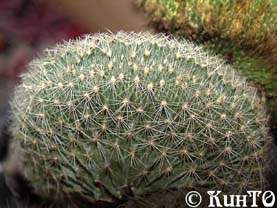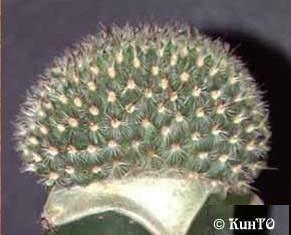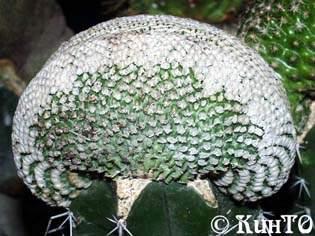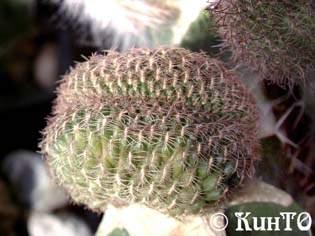The role of inherited fasciations in the forming of cacti
By I.M. Skulkin
 |
| Photo 1. Hamatocactus setispinus |
The problem of the nature of fasciations (abrupt changes of organ forming activity of meristems) and their role in the evolution of higher plants has always been of much interest. Some authors like White (1945) consider fasciations to be abnormal, others like Bakeberg (1932) and Bucksbaum (1950) do not consider them as teratological changes and underline that fasciations are found at healthy strong plants. Many authors believe that the fasciation of core organs, flowers, inflorescences and fruit played an important role in forming angiosperms.
The influence of fasciations on forming cultivated plants is the best studied (Krenke, 1950; Zhukovsky, 1950; Danilova, 1951-1952; Fedorov, 1958; Filov, 1961; Shavrov, 1961).
The classic example of inherited fasciation is crested form of Celosia cristata. Good examples of fasciations are ear, sunflower anthodium, strawberry and tomato collective fruit. Zhukovsky (1950) believes that fasciation underlines the origin of such cultivated plants as soybean, cauliflower, beetroot, yam, pineapple, standard peas and haricot, some of Cucurbitaceae and others.
 |
| Photo 2. Mammillaria microhelia |
Fasciations are widely spread among flowering plants both in nature and in culture, though the possibility of their occurrence is not the same at different families. Out of 290 families (by Angler's system) the fasciations were found at least in 102 of them (White, 1916). There are no direct proofs of absence of fasciations in any of taxonomic groups of vascular plants (White, 1945).
It is quite possible that the frequency of fasciations is higher at introducents and cultivated plants. L.A.Shavrov (1961) registered several thousands (!!!) of fasciations of introducents during 4 years in the Polar Alpine botanic garden. Fasciations were found at 35 species of Asteraceae family, Ranunculaceae - 26, Ziliaceae - 16, Polygonaceae - 10, Rosaceae - 8, Boraginaceae - 7, Campanulaceae - 5, Scrophulariaceae and Primulaceae - 4, Caryophyllaceae, Papaveraceat and Zamiaceae - 3, Fabaceae and Poaceae - 2, Brassicaceae, Crassulaceae, Gentianaceae, Polemoniaceae - 1. It is believed that most often fasciations occur in the following families: Onagraceae, Rosaceae, Fabaceae, Asteraceae and Cactaceae (Filov, 1961). The fasciations of the last family in the list are of special interest.
Types of fasciations in Cactaceae family
Cactaceae family includes more than 3000 species mostly of stem succulents spread in South, Central and North America and partly naturalized in the Mediterranean, Africa, Australia and South-East Asia.
Inside the family the main direction of evolution was:
- gradual reduction of transpiring and photosynthesizing surface due to the reduction of leaves;
- thickening of stems due to the extension of parenchyma of primary bark;
- merger of podariums of leaves with it;
- development of special lower ovary by peduncle increase;
- alteration of water change (use of endogenous water) and
- assimilation of carbon.
 |
| Photo 3. Pelecyphora valdeziana |
It is quite possible that the high degree of succulent characteristics presupposes the development of different fasciations that all feature the increase of surface with respect to the volume of the plant. The increase of photosynthesizing surface leads to better carbon nutrition and faster growth of fasciated plants. According to our observations fasciated plants of all species grow faster than normal ones which corresponds to the opinion of most authors (Bakeberg, 1932; Sneider, Weber, 1966; Bowk, Ross, 1978).
The analysis of cacti kept in the Main Botanic Garden (Moscow), Botanic Garden of Ekaterinburg and private collections in Russia proves that the frequency of fasciations in a taxon correlates with the degree of succukent characteristics of stems. Among widely spread fasciated plants there are Cereus peruvianus, Haageocereus versicolor, Cephalocereus senilis, Weberbauerocereus johnstonii, Parodia mutabilis, Brasilicactus haselbergii, Notocactus scopa, Mammillaria zeilmanniana, Turbinicarpus polaskii - that represent the most advanced tribe Cereeae Br. & R. emend. Backbg., which grows in arid conditions and are remarkable for the high degree of succulent characteristics.
 |
| Photo 4. Sulcorebutia crispata |
We should mention a primitive subfamily Pereskioideae K.Shc. and tribe Hylocereeae Backbg which grow in the conditions of sufficient or excessive humidity, have a high percentage of photosynthesizing surface to the volume of the plant and have almost no fasciations.
If we take into consideration the secondary origination of forest cereus from the species with high degree of succulent characteristics it becomes obvious that environmental conditions are more important for the appearance of fasciations than the origin of the species with high frequency of fasciations.
A larger number of fasciations found at xerophytes as compared with hydrophytes were mentioned earlier for other families as well. Among succulents the frequency of fasciations is most likely to be at evolutionally advanced taxons with highly specialized vegetative organs, other conditions are equal.
The fasciations of cacti may have different causes, mechanism of development and correspondingly different structure. By convention one can single out three morphological types of fasciations which can transform to each other during ontogenesis of the plant.
Cristation
Cristation is abnormal development of stem when the affected zone gets flattened or ribbon (White, 1948). In other words cristate forms appear as a result of extension of apical meristem and the following unlimited growth. Meristem keeps its histological zoning, and its width reduces slightly (Bowk, Ross, 1978). As a result of unlimited growth of linear meristem the stem gets flattened, areolae with thorns are situated on all the surface of the crests. The number of parastichs increases but the structure of areolae themselves does not practically change.
Depending on the age there are fan-shaped, wavy and brain-shaped crests (Bowk, Ross, 1978). More thick crests seldom grow into brain-shaped, e.g. crests of Carnegia gigantea. Crests may remain at any stage for a long time. But at the stage of brain-shaped crest when the curves begin to crowd defasciation occurs rather often. That is the linear meristem turns into a number of small apical meristems that form normal shoots. More seldom you can find defasciation occurred without any reason at an earlier stage of the development of the crest.
In general with age meristem gets less active or not active at all. The growth continues only at some parts of linear meristem. Thanks to this process the upper surface becomes uneven. The more active parts are usually situated at its ends.
This type of developing crest prevails among cacti, and for a long time it was considered to be the only possible (Bowk, Ross, 1978). Practically in all the species of advanced Cereeae Br. & R. emend. Backebg. tribe one can find the cases of such fasciations. But there is a different way of developing crests first described by Johnson (1969). It was stem succulent Stapelia, Asclepiadaceae family. In this case apical meristem starts branching in the dichotomic way on one level. Daughter meristems differ from normal only in smaller size. The resulting fan-shaped shoot becomes integral owing to accretion of cortical layers.
We watched a similar multiple dichotomy at North American cactus Turbinicarpus loph. The crest developed this way differs from a normal one even in its exterior - one can see the web of groups of clusters branching dichotomically on the lateral surface. The upper surface of the crest is knobby.
The crest of Turbinicarpus loph has another specific feature. In spite of its rather large size (the height of the crest is about 4 cm) the areolae kept their juvenile structure as the thorns were white, had pinnate surface and were situated like at the seedlings of the species.
Consequently, as Bogumil Shuts (1977) indicated, the physiological age of crest may not depend on its real age and be determined by the stage of the development at which it appeared. It is quite possible that the crest that appeared at a juvenile plant will not be able to bloom during its life-time. It can explain the fact mentioned by most authors (Snider and Weber, Shuts, Bowk and Ross) that crest forms bloom rarely.
In the ontogenesis a crest can appear any time, but development of crests at large highly succulent North American species in the early stages of ontogenesis is unlikely. For instance, the youngest crest of Carnegia gigantean mentioned by Snider and Weber (1966) was more than 90 cm high and about 30 years old.
On the other hand, a 1 week old (that is before areolae appeared) seedling of South American Notocactus submammulosus v. Pampeanus that we watched looked like a real crest. It was crest-shaped and had multiple cotyledons on its sides. That means fasciations can take place even in the first days of a seedling or at the stage of the forming of the embryo in the seed.
As practice shows when cactus fanciers grow cacti out of seeds fasciations often take place at germs and juvenile plants especially when the regime changes (temperature, humidity, grafting onto a strong stock). It also takes place in the middle or at the end of generative period without any apparent reasons.
Translation Irina Koudina, Mosсow, Russia, e-mail: irink@os2.ru





